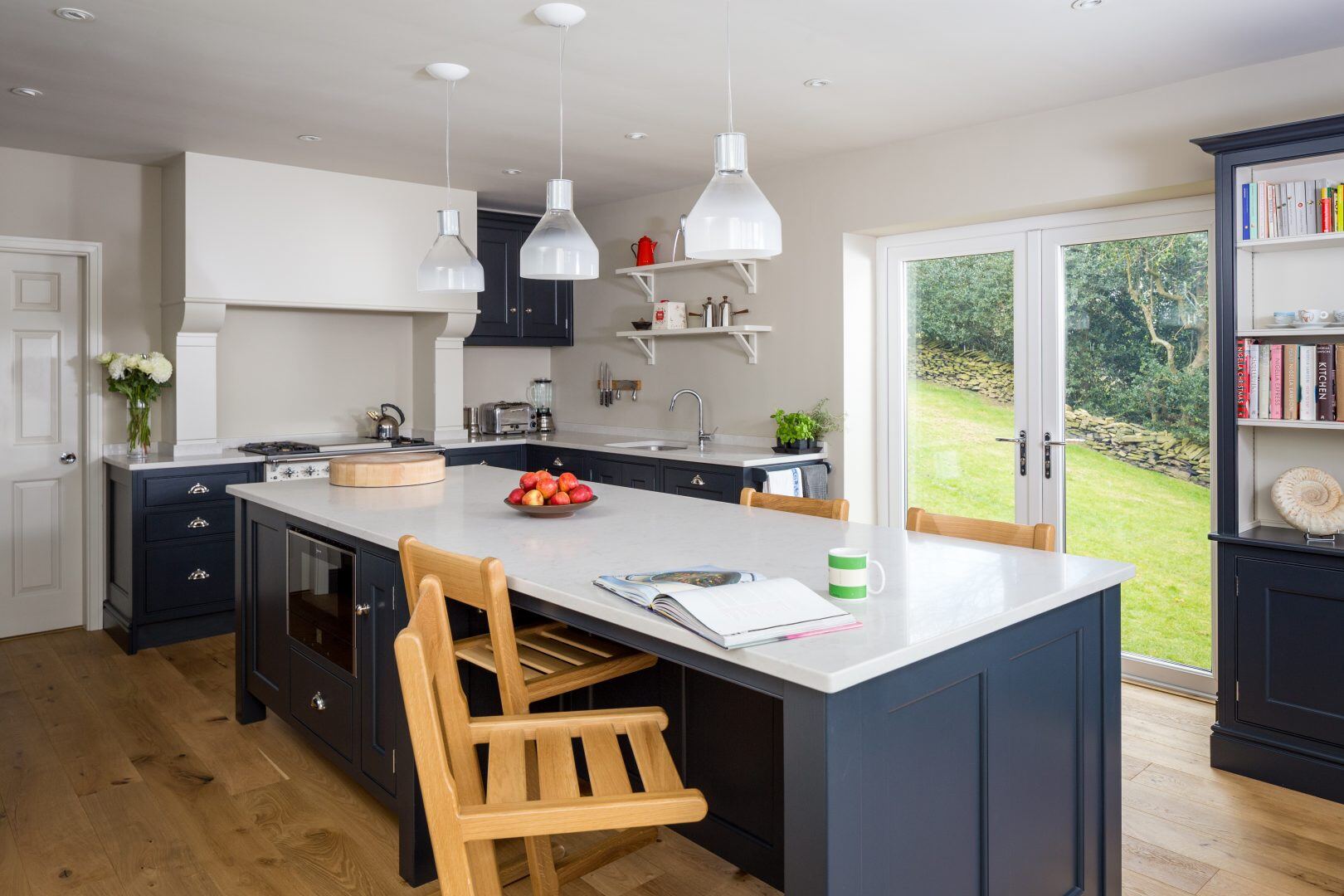
Practicality VS Style: Getting the Balance Right in Kitchen Design
When it comes to getting the Balance Right in kitchen design, there are two main sides that make up a hard-working and beautiful kitchen: practicality and style. Focus too much on style, and you’ll certainly have a kitchen that looks amazing but may not be fit for purpose. Focus too much on the practicality, and your kitchen may be lacking that wow factor, homely feel or continuity with the rest of your home.
It is possible to achieve both practicality and style - it’s all about creating balance and making smart and informed decisions. If you’re embarking on a kitchen redesign, this is a must-read…
Practicality: Why it Matters

For many, the kitchen is the heart of the home. On average, we spend an hour and a half to two hours in our kitchens every day, which is often a large portion of your time spent at home. Because of this, not only should your kitchen be a joy to spend time in, it should also work with you to help you with the various tasks you carry out here.
Cooking is, of course, the main function of the kitchen, but for those without a utility room, the kitchen is also used for laundry, dishwashing and often to house cleaning products too. If you have a large enough kitchen to include a dining table, then your space also needs to function for eating. Finally, the kitchen is the space in the house that everyone seems to gravitate towards, meaning it has to work for socialising as well.
That’s a lot of functions for one single room to provide for. This might make kitchen design seem like it’s really complex, but first and foremost you need to sit down and think about what you need your kitchen to do, to meet your individual needs.
Creating a practical kitchen is all about function and how easily each element of your kitchen works for its purpose. There’s no sense in focusing on the social element, trying to fit in a table and breakfast bar, leaving you little room for storage and prep space. Consider how you use your kitchen day-to-day, what does it need to do to make life easier for you? Once you’ve answered these questions, you’ll be far better able to create a kitchen that works for you.

While it may not seem that exciting, the practicality of your kitchen is crucial to how well the room works. When you’re spending a lot of time and money on redesigning your kitchen, it’s important to think ahead and be confident that what you choose will still work brilliantly in years to come, rather than discovering little irritations and elements later down the line that hold you back from using your kitchen how you really want to.
Style: Why it Matters
Style is, of course, the more exciting element of kitchen design and it plays a huge role in how well your kitchen works. The style and decor of any room change how you feel when in the space. For example, a bright, light and the airy room might make you feel wide awake and energised yet calm, while a dark room with lots of soft furnishings and low-level lighting might make you feel cosy and sleepy.

In the kitchen, we generally want to feel focused and alert, making the colours that you choose and your lighting key. However, as mentioned above, your kitchen needs to serve a number of purposes. In open-plan kitchen-diners, a cosier feel might be necessary for your dining space, while your kitchen area should remain light and bright. This can be achieved by zoning your open plan room, using lighting, materials and even a feature wall to separate the two areas.
It’s really important that you actually like your kitchen too. Making sure it’s practical and it works brilliantly is all well and good, but actually enjoying being in your kitchen is half the battle. When we like the space we are in, we feel positive and uplifted, so choosing a kitchen that suits your style is much more important than you might think.
You should also consider trends VS timeless design. A kitchen is typically an investment piece, and many of us will only replace the kitchen in our home once during the time that we live there. Try not to get carried away with current trends, as these come and go and maybe dated within a few years. If there are some trends that you really love, consider incorporating these into your kitchen design through elements that are easy to replace, such as tiles and lighting. Go for a timeless design for units, doors and worktops to ensure your new kitchen will work just as well now as it will in five years time.
Getting the Balance right with Clever Kitchen Design

When it comes to planning your kitchen design, sit down and write down the important elements. What do you want your kitchen to do? How do you want to feel when in the space? Remember that neither practicality nor style should be more important than the other - the key to getting your kitchen spot on is to create a balance between the two. These are your goals and should not be compromised on unless absolutely necessary. An example of your main aims might look a little like this:
The kitchen needs to:
Offer enough storage space to keep draws and cupboards fairly clear making it easy to access everything
- House two built-in ovens to help with hosting dinner parties
- Offer enough space for a four-seater dining table
- Provide bright task lighting for cooking, but dimmable lighting for eating
- Make me feel calm yet alert when cooking, but relaxed, comfortable and at home when eating
As you start to consider layout, appliances, lighting and other design choices, always come back to your starting point and what you need your kitchen to do to ensure you don’t stray from this.
Your kitchen should work together seamlessly, so take the time to carefully consider every element, from worktops and door colours, to handles, lighting and wall colours. Remember that some elements might be easy to replace in the future should you want to refresh your kitchen, such as repainting the walls or replacing the handles - get the bones right and you’ll be able to enjoy your kitchen for years to come, even if you do choose to change the wall colour in the future.

By focusing on the big decisions and the balance at this stage, you can future proof your design and create a space that works for the whole family.
Top Tips for Redesigning your Kitchen
Now that you understand how to create a lance between practicality and style, here are a few more tips and things to consider…
- Go Bespoke:

One of the best ways to ensure your kitchen both looks amazing and works brilliantly is to go bespoke. While off the shelf kitchens might appear to fit OK and work well to start with, as you spend more time in your kitchen, you’ll quickly realise this isn’t the case after all. A bespoke kitchen will allow you to create storage and appliance housing that fits your space like a glove. In addition, bespoke kitchens provide so many more options than an off the shelf kitchen ever could, ensuring you can create your ultimate kitchen for your own unique needs.
- Consider your working triangle:
The working triangle refers to the triangle shape that is formed between the oven, sink and fridge/freezer. This triangle ensures these three zones are connected and that you can move freely between each area, making your kitchen more efficient.
- Invest in quality:
Your kitchen is likely to be the biggest investment you will make in your home. Any kind of kitchen can be expensive, but having it fit will cost a lot too. For many, this is something you only want to do once, so invest in quality to ensure that your kitchen not only lasts for years to come but still looks great in ten or even twenty years time. Choose solid wood units over cheaper alternatives, go for granite worktops over laminate, and choose a bespoke handmade kitchen over a mass factory produced design.
- Create a cohesive scheme:

Cohesion in the home refers to the flow and how well one room and even the whole house ties together. You can link elements in a room together through colour, pattern, texture and materials to create a scheme that works as one. If you go for dark units, mirror this in your lighting and accessories. Choosing brass handles? Swap door and window handles for brass too, and display a few brass accessories on open shelving.
- Zone lighting:
Lighting is really important in the kitchen and has the ability to enhance your design and how you use the space. Over your units, consider bright spotlights for task lighting, but make sure they are installed above the units, rather than behind your head which will create a shadow. Over your dining table, choose a pendant light to zone this space and add low-level lighting for dining and socialising. Dimmable spotlights are also great, as they enable you to create a bright light throughout the space, or a low-level light, depending on the mood and occasion. If you do instal any pendant lights or wall lights, make sure they can be switched on independently to your spotlights to give you lots of lighting options.
- Choose fully integrated:
Fully integrated kitchens are a must if you want to create a high-end finish and timeless design. In choosing a bespoke kitchen, you can opt to have everything integrated, from your dishwasher to your microwave, and can also include other helpful storage solutions such as a built-in pantry with drawers, shelves and spice rack.
- Consider your space:

whether you choose base units alone, wall units, floor to ceiling cupboards, an island unit or a connected breakfast bar largely depends on the space available. In a Victorian terrace, for example, kitchens can be long and narrow, so you might avoid wall units as this could bring in the space making it feel smaller. Instead, choose a single wall of the wall to ceiling units to maximise storage space, and a wall of base units to create a light and open feel. When it comes to choosing your layout and design, it can be all too easy to get caught up with what’s popular and choose something that doesn’t necessarily work in your space. Take a step back and consider what’s possible, and what would work best for you.
- Think outside the box: If you’ve chosen to go bespoke, almost anything is possible. You’re not shopping off the shelf, so why not consider exactly what you want as an individual. If you spot a great idea in a magazine or online, save it and share with your kitchen designer, or if you have an idea, create a rough sketch and have it made. Bespoke means you no longer have to work with a ‘one size fits all’ kitchen, so take advantage of this.
There’s a lot to consider when it comes to redesigning your kitchen to achieve practicality as well as style, but it’s well worth taking the time and spending that little bit extra to make sure you get it right the first time around. For further help or to get started on creating your own bespoke kitchen, don’t hesitate to get in touch: https://drewforsyth.co.uk/contact-us/

